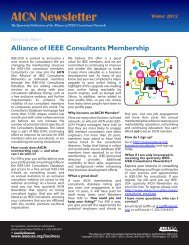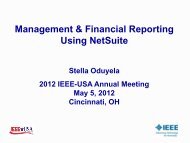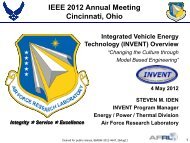Next Generation Internet: IPv4 Address Exhaustion ... - IEEE-USA
Next Generation Internet: IPv4 Address Exhaustion ... - IEEE-USA
Next Generation Internet: IPv4 Address Exhaustion ... - IEEE-USA
You also want an ePaper? Increase the reach of your titles
YUMPU automatically turns print PDFs into web optimized ePapers that Google loves.
When the NTT Communications’ redistribution server receives the alert message from<br />
JMA’s distribution server it propagates the alert via IPv6 multicast to the subscriber base.<br />
The subscriber has a desktop application that is loaded onto the subscriber’s PC and runs<br />
in the background. When the alert is received by the subscriber client application, the<br />
application pops up showing the estimated time to earth movement and the magnitude<br />
that will be felt at the subscriber’s location.<br />
Depending on the magnitude of the earthquake and the distance from the epicenter,<br />
subscribers are given adequate time (10 seconds to 3 minutes) by the alert to take actions<br />
ranging from immediately taking shelter to shutting off the natural gas and water lines to<br />
the house.<br />
Businesses that subscribe to the service, such as a natural gas or water distribution<br />
company, are potentially given enough advance warning that they can issue an<br />
emergency shutdown of the gas or water pipelines in the affected area. If enough valves<br />
are able to be closed before the earthquake hits the affected area, the property<br />
damage to the area can be minimized, as well as giving people enough time to prepare<br />
for the impending earthquake.<br />
Why does this depend on IPv6? It is possible to create such a system using <strong>IPv4</strong>, where<br />
clients behind their NAT open a connection to a central server. Once an event occurs, that<br />
server then sends updates through the established connections. However, this model is<br />
incredibly inefficient, as there is quite a lot of network overhead used to establish and<br />
maintain the connections, as well as keep the NAT pinholes open. Using IPv6 uses much less<br />
network, server, and client resources for the same task.<br />
22

















